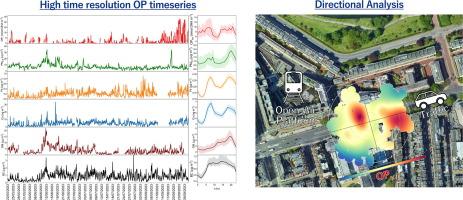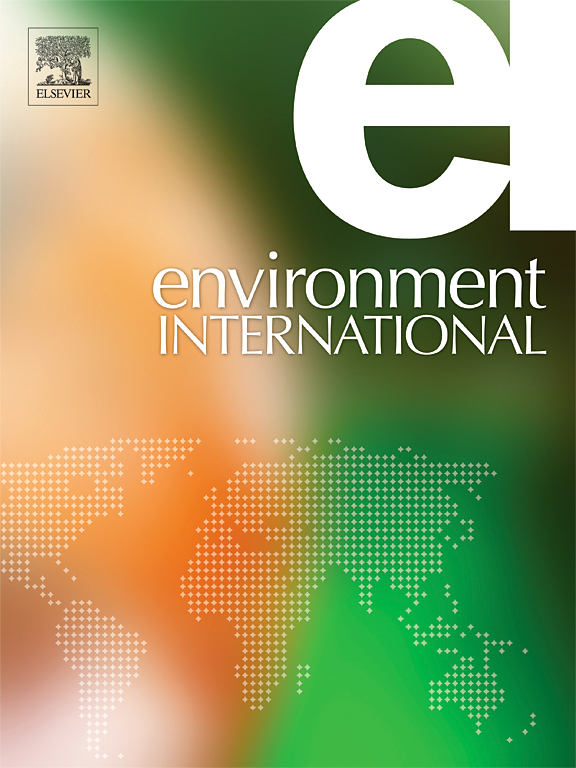High time resolution quantification of PM2.5 oxidative potential at a Central London roadside supersite
IF 10.3
1区 环境科学与生态学
Q1 ENVIRONMENTAL SCIENCES
引用次数: 0
Abstract
The oxidative potential (OP) of airborne particulate matter (PM) is gaining increasing attention as a health-relevant metric to describe the capacity of PM to promote oxidative stress and cause adverse health effects. To date, most OP studies use filter-based approaches to sample PM and quantify OP, which have relatively poor time resolution (∼24 h) and underestimate the contribution of reactive components to OP due to the time delay between sample collection and analysis. To address this important limitation, we have developed a novel instrument which uses a direct-to-reagent sampling approach, providing robust, continuous, high time resolution (5 min) OP quantification, hence overcoming analytical limitations of filter-based techniques. In this study, we deployed this instrument in the Marylebone Road Air Quality Monitoring Station in London, UK, alongside a broad suite of high time resolution PM2.5 composition measurements for three months continuous measurement during Summer 2023. High time resolution OP quantification reveals dynamic changes in volume-normalised (OPv) and mass normalised (OPm) OP evolving over ∼hourly timescales, observed at an average PM2.5 mass concentration of 7.1 ± 4.2 µg m−3, below the WHO interim 4 target of 10 µg m−3. In addition, high time resolution data facilitates directional analysis, allowing us to determine the influence of wind speed and wind direction on OP, and the identification of PM2.5 chemical components and sources which drive dynamic changes in OP; this includes traffic emissions, as well as emissions from the London Underground into the ambient airshed. These results demonstrate the capacity of high time resolution measurements to provide new insights into the temporal evolution of OP, as well as the composition and emission sources which drive OP, developing our understanding of the characteristics of PM2.5 which may promote adverse health impacts.


伦敦市中心路边超级站点 PM2.5 氧化潜能的高时间分辨率量化
空气中颗粒物(PM)的氧化潜能(OP)作为一种与健康相关的指标,越来越受到人们的关注,因为它可以描述PM促进氧化应激和造成不良健康影响的能力。迄今为止,大多数 OP 研究都采用基于过滤器的方法对 PM 进行采样并量化 OP,这种方法的时间分辨率相对较低(∼ 24 小时),并且由于样品采集和分析之间的时间延迟,会低估活性成分对 OP 的贡献。为了解决这一重要的局限性,我们开发了一种新型仪器,它采用直接对试剂采样的方法,提供稳健、连续、高时间分辨率(5 分钟)的 OP 定量,从而克服了基于过滤器技术的分析局限性。在这项研究中,我们在英国伦敦玛丽伯恩路空气质量监测站部署了这一仪器,并在 2023 年夏季进行了为期三个月的连续测量,同时还进行了广泛的高时间分辨率 PM2.5 成分测量。高时间分辨率 OP 定量揭示了体积归一化(OPv)和质量归一化(OPm)OP 在每小时时间尺度上的动态变化,观测到的 PM2.5 平均质量浓度为 7.1 ± 4.2 µg m-3,低于世界卫生组织中期目标 4 10 µg m-3。此外,高时间分辨率数据有助于进行方向分析,使我们能够确定风速和风向对 OP 的影响,并确定 PM2.5 的化学成分以及推动 OP 动态变化的来源;这包括交通排放以及从伦敦地铁排放到环境空气流通中的气体。这些结果表明,高时间分辨率测量能够提供有关 OP 的时间演变以及驱动 OP 的成分和排放源的新见解,从而加深我们对可能对健康产生不利影响的 PM2.5 特征的理解。
本文章由计算机程序翻译,如有差异,请以英文原文为准。
求助全文
约1分钟内获得全文
求助全文
来源期刊

Environment International
环境科学-环境科学
CiteScore
21.90
自引率
3.40%
发文量
734
审稿时长
2.8 months
期刊介绍:
Environmental Health publishes manuscripts focusing on critical aspects of environmental and occupational medicine, including studies in toxicology and epidemiology, to illuminate the human health implications of exposure to environmental hazards. The journal adopts an open-access model and practices open peer review.
It caters to scientists and practitioners across all environmental science domains, directly or indirectly impacting human health and well-being. With a commitment to enhancing the prevention of environmentally-related health risks, Environmental Health serves as a public health journal for the community and scientists engaged in matters of public health significance concerning the environment.
 求助内容:
求助内容: 应助结果提醒方式:
应助结果提醒方式:


